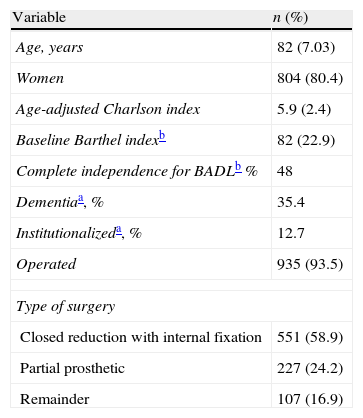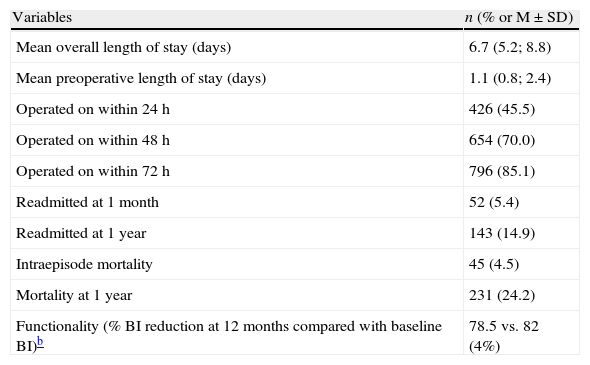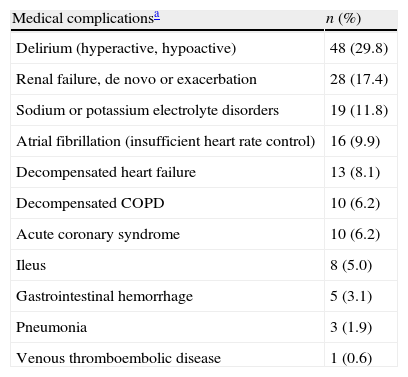To report the health outcomes of a multidisciplinary care program for patients over 65 years with hip fracture.
Patients and methodsWe have developed a care coordination model for the comprehensive care of hip fracture patients. It establishes what, who, when, how and where orthopedists, internists, family physicians, emergency, intensive care, physiotherapists, anesthetists, nurses and workers social intervene. All elderly patients over 65 years admitted with the diagnosis of hip fracture (years 2006–2010) were retrospectively evaluated.
ResultsOne thousand episodes of hip fracture, corresponding to 956 patients, were included. Mean age was 82 years and mean stay 6.7 days. This was reduced by 1.14 days during the 5 years of the program. A total of 85.1% were operated on before 72 yours, and 91.2% during the program. Incidence of surgical site infection was 1.5%. In-hospital mortality was 4.5% (24.2% at 12 months). Readmissions at one year was 14.9%. Independence for basic activity of daily living was achieved by 40% of the patients.
ConclusionsThis multidisciplinary care program for hip fracture patients is associated with positive health outcomes, with a high percentage of patients treated early (more than 90%), reduced mean stay (less than 7 days), incidence of surgical site infections, readmissions and inpatient mortality and at one year, as well as adequate functional recovery.
Presentamos los resultados en salud de un programa de asistencia multidisciplinar a pacientes con fractura de cadera mayores de 65 años.
Pacientes y métodosHemos desarrollado un modelo de coordinación asistencial para la atención integral del paciente con fractura de cadera, estableciendo qué, quién, cuándo, cómo y dónde intervienen traumatólogos, internistas, médicos de familia de urgencias, intensivistas, fisioterapeutas, anestesistas, enfermeros y trabajadores sociales. Se evaluaron retrospectivamente todos los pacientes mayores de 65 años que ingresaron con diagnóstico de fractura de cadera (años 2006 a 2010).
ResultadosSe incluyen 1.000 episodios de fractura de cadera ocurridos en 956 pacientes. La edad media fue de 82 años y la estancia media de 6,7 días, reduciéndose 1,14 días en los 5 años del programa. Antes de las 72h se intervinieron el 85,1%, y el 91,2% a lo largo del programa. La incidencia de infección quirúrgica fue del 1,5% y la mortalidad intrahospitalaria del 4,5% (24,2% a los 12 meses). Al cabo de un año reingresaron el 14,9%, y el 40% de los enfermos consiguieron ser independientes para las actividades básicas de su vida diaria.
ConclusionesEste programa de atención multidisciplinar al paciente con fractura de cadera se asoció a resultados beneficiosos en salud, con un elevado porcentaje de pacientes intervenidos precozmente (más del 90%), una reducida estancia media (menos de 7 días), incidencia de infecciones quirúrgicas, reingresos y mortalidad intrahospitalaria y al año de seguimiento, así como una adecuada recuperación funcional.
Article
Diríjase desde aquí a la web de la >>>FESEMI<<< e inicie sesión mediante el formulario que se encuentra en la barra superior, pulsando sobre el candado.

Una vez autentificado, en la misma web de FESEMI, en el menú superior, elija la opción deseada.

>>>FESEMI<<<








